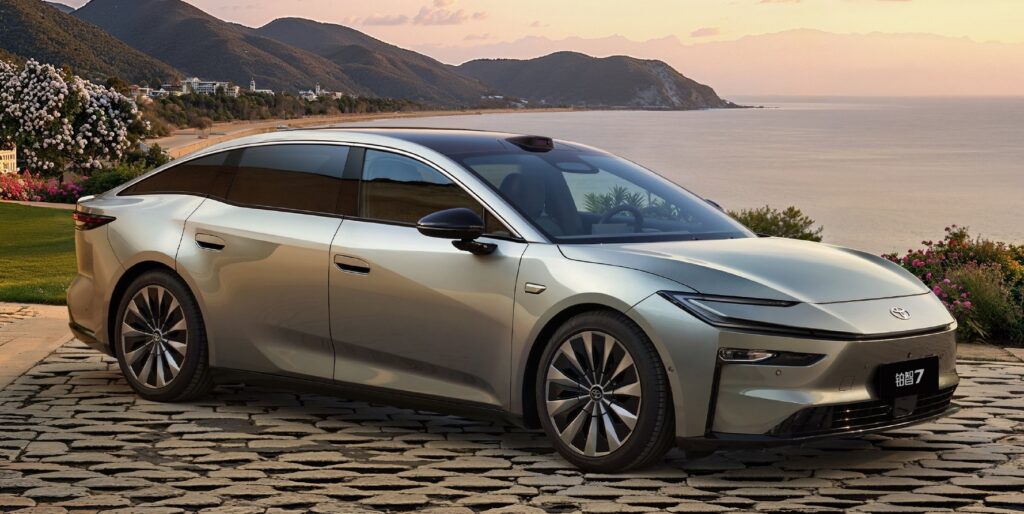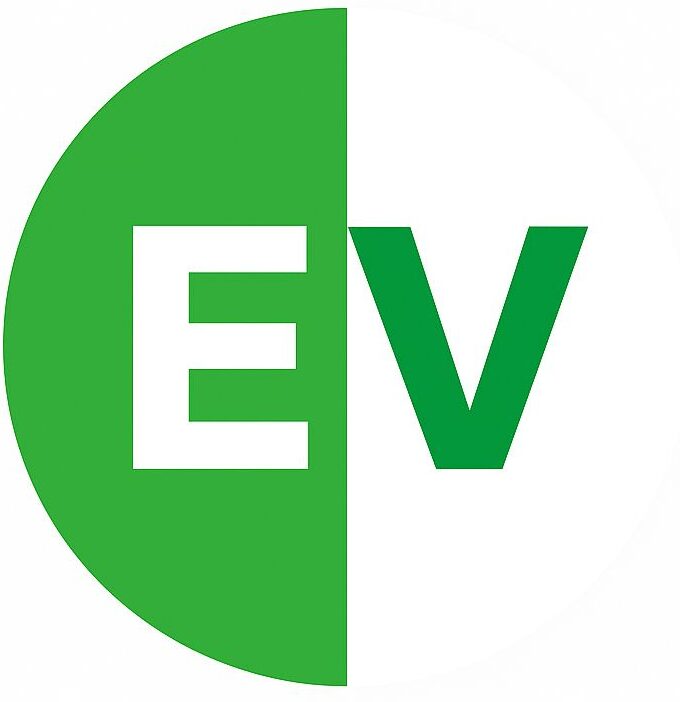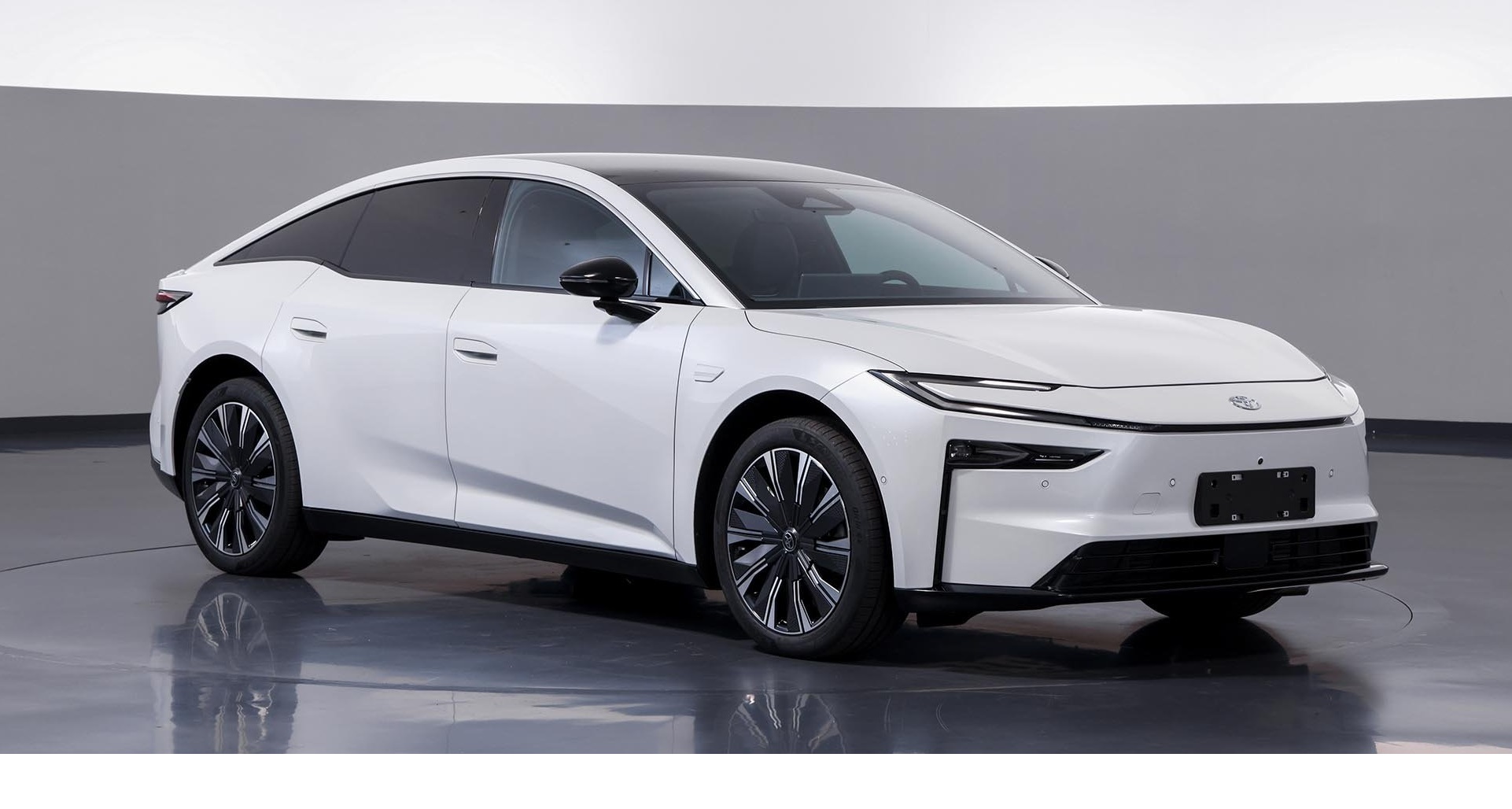
In 2025, the EV industry has stopped being just about range numbers or charging speeds. The battle has shifted toward who owns the driver ecosystem. In China, where EV penetration is already above 35% the car has transformed into a smartphone on wheels connected, intelligent and plugged into a wider digital life. Against this backdrop Toyota has taken a bold step unveiling the bZ7 a flagship electric sedan developed through its joint venture with GAC and embedding it with Huawei HarmonyOS and Xiaomi smart-home ecosystem.

The unveiling is not just another model launch. It signals how traditional automakers like Toyota are rethinking their EV strategy to survive in markets dominated by BYD, Tesla and NIO. For EVCarBazaar the Toyota bZ7 matters not only because of what it is today, but because of what it represents for the global EV trajectory.
The Unveiling Moment

The bZ7 was revealed in China under the GAC-Toyota joint venture, which has become Toyota key bridge into the world most advanced EV market. This is the first large sedan in the brand bZ (Beyond Zero) lineup. Positioned above the existing bZ4X crossover the bZ7 aims directly at China booming premium EV segment a space where consumer expectations are not limited to comfort or power but extend to AI assistants, connected ecosystems and OTA-driven upgrades.
Design-Physical Presence


At over 5.1 meters in length the Toyota bZ7 is unmistakably large. With exact dimensions of 5130mm in length, 1965mm in width, 1506mm in height and a wheelbase stretching 3020mm it firmly occupies the luxury sedan class. For perspective, these proportions place it head-to-head with the Tesla Model S and Mercedes EQE.
The car exterior silhouette emphasizes aerodynamics while the cabin promises the space and luxury cues demanded by China affluent EV buyers. At a curb weight of around 2275kg the bZ7 is no lightweight, it carries the heft expected from a flagship sedan with advanced safety and tech features.
Powertrain-Engineering

The Toyota bZ7 is powered by Huawei electric motor delivering 207kW (about 278 horsepower). This places it comfortably in the performance range of premium sedans offering a top speed of 180km/h.
The battery pack comes from CALB-Tech and uses LFP chemistry a choice that emphasizes durability, cost efficiency and safety. Exact driving range figures are still pending certification but expectations within the industry are that the bZ7 will compete with the 600–700km range offered by peers in its segment.
Toyota and GAC have not confirmed fast-charging curves or official range yet. EVCarBazaar will update this section when certifications are published.
The Tech Core: HarmonyOS + Xiaomi


The bZ7 real headline feature is not its motor or its size but its brain. Toyota has chosen Huawei HarmonyOS cockpit system to power the infotainment and connected services. This marks the first time Toyota has integrated a Chinese operating system of this scale into one of its flagship EV. HarmonyOS turns the dashboard into an extension of Huawei ecosystem apps, navigation, entertainment and connectivity all run on the same OS used in Huawei smartphones and tablets.

Huawei DriveONE powertrain platform further integrates electronics, inverter and motor into a seamless unit underscoring how deeply tech companies are entering EV engineering.
Then comes Xiaomi. The bZ7 links directly with Xiaomi smart-home ecosystem creating what GAC-Toyota calls a “Human × Car × Home” experience. From inside the car drivers will be able to control household devices air conditioners, lighting and appliances just as they would from a Xiaomi phone.
The ADAS story adds another layer a roof-mounted LiDAR unit supplied through Huawei ecosystem and autonomy partner Momenta promises Level 2+ driver assistance. This includes adaptive cruise, lane centering and city navigation support.
China Market Positioning

The Toyota bZ7 is aimed squarely at the high-end EV buyer in China consumers who demand luxury but also value cutting-edge tech integration. China NEV (New Energy Vehicle) mandate and generous subsidies have made this market a laboratory for connected EV and Toyota knows that to stay relevant it cannot simply offer hybrids.
By linking with Huawei and Xiaomi Toyota is effectively outsourcing the “smart” side of its EV to China most trusted tech ecosystems. This is a major shift for an automaker that has historically relied on in-house infotainment.
Global Perspective

The global story of the Toyota bZ7 is complicated.
- India– Toyota strong reputation could help but HarmonyOS faces limited recognition and EV infrastructure is still catching up. If localized the bZ7 could be a halo product to build confidence in Toyota EV strategy.
- Europe– EU’s “Fit for 55” climate package is pushing hard on electrification but software ecosystems may face data compliance challenges. Toyota may need to adapt the bZ7 to European privacy standards.
- United States– The car size and luxury fit align with the US market but HarmonyOS is unlikely to be allowed due to geopolitical restrictions. An Android Automotive-based variant might be required.
Competitive Landscape

The bZ7 will inevitably be compared against:
- Tesla Model S– The benchmark for software-first EV sedans.
- Mercedes EQE– Traditional luxury translated into EV form.
- BYD Han EV– A homegrown Chinese success story that combines affordability with strong specs.
EVCarBazaar View- Toyota advantage is brand trust and global scale but in China software stickiness often beats legacy reputation.

The Toyota bZ7 is more than a sedan it’s a signal of how automakers are redefining themselves in a world where tech companies dominate the user experience. The success of the bZ7 will depend less on horsepower and more on how smoothly HarmonyOS, DriveONE and Xiaomi ecosystem integrate into daily life.
The bZ7 shows a pivot from hybrid-first engineering to EV-first ecosystems. The key watchpoints now are official range certification, pricing announcements and whether Toyota dares to export a HarmonyOS-powered EV beyond China.
Cars are no longer just machines. The Toyota bZ7 proves they are becoming portals into digital empires. In fusing Japanese engineering with Chinese software ecosystems Toyota has drawn a bold map of the EV future one where mobility, connectivity and daily life are inseparable.

